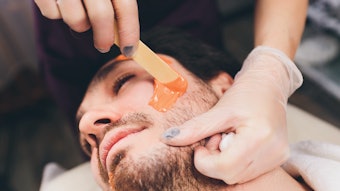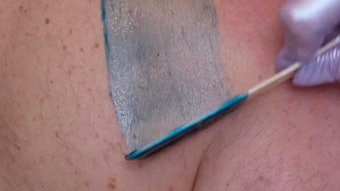
Marta Ivaskevych was 18 years old when she was diagnosed with polycystic ovary syndrome, or PCOS. She knew something was up when she started struggling with her weight. During her appointment with her gynecologist, who told her about some of the other symptoms, such as irregular periods, Ivaskevych noted that she didn’t seem to suffer from the other hallmarks of the condition and that, for the most part, she felt fine. It wasn’t until two years later that she started experiencing a terrible pain on her left side where her left ovary was, that she got an ultrasound and was diagnosed with a cyst. She got an operation to remove it only to have to undergo another procedure just a year later.
As if the pain of ovarian cysts and the stress of 2 procedures wasn’t enough, a few months later Ivaskevych noticed a couple of hairs on her chin. As this wasn’t something that happened before, she went back to her gynecologist who suggested she get laser hair removal. “I didn’t know much about it at the time,” says Ivaskevych, “but I decided that if it was something the doctor recommended, it was something I should do.” They shaved her entire face and neck first, to ensure the laser effectively targeted the follicles and to mitigate the risk of burning and irritation—this, Ivaskevych says firmly, was the first problem. “I wasn’t the expert, so I just trusted them.”
Laser hair removal is a treatment that requires consistency with clients needing to return every month or so for the best results. Ivaskevych recalls that she did exactly that, her voice breaking“it’s just remembering this, everything, is not easy.” She continued with her treatments, losing faith that this was the best option for her in the meantime, although what else was she to do when it was her face and she was a young professional building her career? In total, Ivaskevych underwent about 4 or 5 treatments, “and then the hair started to grow.” The hair returned with a vengeance, going from the two hairs on her chin to cover her full face and neck. “It was horrible,” says Ivaskevych, noting her lighter complexion, “and the hair was so dark. It was so noticeable, it was so bad.”
Ivaskevych was referred to an electrologist who assured her that the treatment would be permanent. “I was probably a little rude,” she admits. “I’d already heard ‘permanent’, I did what the doctor told me, I did everything. [The hair growth got] worse.” After her treatments, she recalls running to the bathroom each morning to check for new growth. When electrolysis proved successful and her struggle to manage unwanted hair growth came to an end, Ivaskevych would excitedly regale those around her with the success of her treatments until eventually, her boyfriend encouraged her to do something with it. “I wanted people to know about it,” says Ivaskevych. “In 2017, it felt like nobody knew about it! I wanted people to know that there was a solution, especially those girls who were like I was a year ago, but what should I do?” At the time, she was a general manager.
By the time Ivaskevych started working as an electrologist on her own, she was in a much better place: her treatments were done and she’d successfully managed the symptomatic hair growth from PCOS. That doesn’t mean she’d turned the page on that chapter of her life. Turning a grueling diagnosis into her life’s calling, these days Ivaskevych is busy with her work as an electrologist. “As a specialist in the field, I recommend laser hair removal for naturally occurring growth,” she says, meaning places people commonly get done, like their legs, under arms and the bikini area. Since it’s rarer for women to have thicker hair growth on their faces, chests and stomachs, excessive growth in those areas could be an indicator of a hormonal disorder like PCOS, which means laser treatment may not be the right path and may result in paradoxical hypertrichosis, similar to Ivaskevych’s experience. It's a rare side-effect of laser hair removal, but hormonal imbalances like the ones that accompany a PCOS diagnosis can increase your risk of paradoxical hypertrichosis. She also recommends that people do their research prior to seeking out treatment. The allure of electrolysis is that it’s permanent, but Ivaskevych warns that there are individuals who perform the treatment without being licensed for it. “Where I am now, in Florida, it’s not that popular. For example, in New York, you can find electrolysis as easily as you can find laser hair removal. Where I live, there are only a few salons that I know.” She’s wary when she gets inquiries about the machinery she uses from strangers, “your school should advise you,” she says. It’s impressive tech, and the lure of electrolysis can be strong, with some getting inspired to pursue it as a career after seeing it on social media. While a passion for the practice is important, professional training and licensure is crucial.
With other methods of hair removal, like waxing, shaving or plucking, you run the risk of disturbing the blood vessels and nerves under the hair follicle which can lead to irritation or scarring. Additionally, the resulting regrowth may appear thicker, coarser, or like it's coming back faster, due to the blunt ends of the hair. With electrolysis, the electrical current makes the hair follicle weaker and weaker each time until the existing hair is destroyed and future growth is prevented. That’s why it’s imperative for clients to keep the treated area dry and to hold off on sun exposure, exfoliation and makeup—undergoing repetitive treatments to weaken hair growth and then going home and lathering on products that could protect, or even encourage, hair growth can plunge people into a vicious, expensive cycle. Ivaskevych even recommends being cautious with moisturizer, but gives witch hazel and tea tree oil her seal of approval.
Ivaskevych feels that offering electrolysis could be a very profitable decision on the part of spas and other similar facilities. “Unfortunately, a lot of women struggle with abnormal facial hair growth,” she goes on to say that even those who don’t may be seeking a more permanent solution after dipping their toe in an alternative hair removal method like laser, which she says is ideal for someone looking for permanent hair reduction, rather than strict removal. Ivaskevych encourages people to examine the circumstances surrounding their hair growth before choosing a hair removal method. “People with diabetes, for instance, and cancer treatments,” she says, as both of these conditions can impact hair growth. It’s crucial for hair removal specialists to understand these as potential factors too, not just so that they can do their job, but for their clients’ comfort. “The person who comes to you will feel more secure with you because you’ll be on the same level as her. You’ll understand her. That’s a lot. To the specialist, I also say, ‘be more patient.’” She says making sure clients know that they’re not alone, that they’re beautiful, that the hair is a temporary obstacle and to follow their post-procedure care (of leaving their faces alone!) will go a long way. “You’ll see your face in 6 months,” she reassures.









